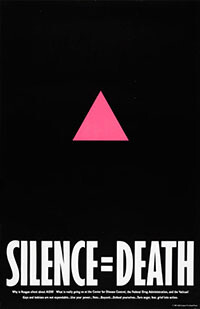Avram Finkelstein Spoke on Resistance and Imagery

Resistance in the twenty-first century means “learning everything about images” according to Avram Finkelstein. On Thursday, February 23, Finkelstein asked attendees at the Schell Center’s human rights workshop to think strategically about what resistance looks like in an image culture.
Finkelstein is a self-proclaimed “red diaper baby,” who has dedicated his life to public and political art. He was a founding member of the Silence=Death collective, Gran Fury, and ACT UP. At the human rights workshop, Finkelstein described how the iconic Silence=Death poster was the result of months of debate and discussion within a group of six friends.

The poster had two key aims; “to prompt the community to organize and to show the outside community we were already organized.” It had to be “cool enough for people to feel included, it had to create an impression of ubiquity, it had to insinuate something… it had to be advertising.” The poster had to fit into the political era of campaign television commercials, it had to “adapt to the catchphrase ‘Morning in America.’”
The composition of the poster was debated in detail. The text at the bottom was intentionally small to encourage people to get closer to the poster and “force people to take part.” The typeface was condensed and the text provocative to catch the attention of people driving and walking past. The text wasn’t concerned with specifics; the aim was to “turn anger, fear, and grief into action.”
Although it later became the iconic image of ACT UP, it was created long before ACT UP. The Silence=Death collective was an independent project formed by a handful of friends. In his talk, Finkelstein expressed that without a community of activists the poster would have gone unnoticed. The poster itself wasn’t an act of resistance; it was a gesture. To Finkelstein, “resistance is a project in flux” where images are gestures not objects.
In reflecting on how resistance looks in 2017, Finkelstein argued, image literacy is lagging behind technology. “We’re living in a time where people run for office because they have a brand.” In this political moment, resistance movements need to understand the role of images and think strategically. Images can be gestures of agency, but to use an image as a logo misunderstands its necessity. Finkelstein ended his talk by arguing that “we have the same tools that has allowed the country to be run as a brand, we have the power of words and images and a content delivery system in our pockets.” Resistance is a project and one where images can have agency.


